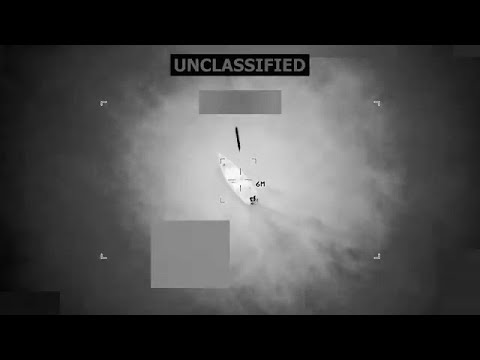Alt Text for Pete Hegseth’s November 1st Boat Strike Video
Like many of the boat strike videos posted to social media by Trump, Hegseth, and the White House, the video of the attack conducted in the Caribbean on November 1st was edited and heavily redacted before its release. Like the other videos, it masquerades as “unclassified” public disclosure, but it discloses almost nothing at all.
We are being asked to rely on the stories Hegseth and other administration figures tell when they post these videos on social media. These accounts have been a problem for me since I first started looking at these boat strike videos — not because I am an expert in military affairs, or South American drug trafficking, but because I can claim some expertise when it comes to the make-believe work of telling stories on video or film.
Moving through these videos shot by shot, and sometimes frame by frame, shows Hegseth to be, at best, an unreliable narrator. (The fancy term for this is proven liar, or, in American idiom, Fox News host.) So, since I’m on a slow New Jersey Transit train with some time on my hands, I thought I’d try a description of my own, and offer alt text for the November 1st video.
The first (low-res, highly pixelated. black and white) shot shows the point of view of the attacker, already in position over the boat. We can make out the wake of the boat, but the vessel itself, the purported target of the strike, is fully redacted. So is the EO/IR interface, and so are any location coordinates. The attacker can see things we can’t.
While it lasts a full six seconds and would seem intended to set the scene, situate the viewer, and show drug smugglers in flagrante delicto, this first shot does nothing of the sort. There is no approach or discovery, no reveal, no new intelligence; the decision to strike has already been taken.
In other words, any visual evidence arguing for the strike, any proof that these are, in fact, the bad guys, the “narcoterrorists,” is being withheld, or perhaps can’t be produced. (And even if these were the bad guys or, what’s more likely, a few desperate mules working for the bad guys, intercepting the boat would make a lot more sense in terms of interdiction and carry the added benefit of not violating international law.) As Representative Adam Smith remarked after an Armed Services briefing, the Pentagon is “telling us is you need less evidence to kill somebody than you do to hold them.”
Then at 00:16:15, two munitions or pieces of ordnance fall from the sky and strike the redacted target. The blast radiates out from the center, but only for a single frame.
Everything goes white, for three frames. The redactions are the only features we can make out against the white.
In the (infrared) shot of the explosion that follows — the one that looks like a camera negative — the camera begins to move off the annihilated target. This shot runs nearly three seconds, from 00:06:17 to 00:09:20, revealing a black sea.
Then something curious happens. At 9 seconds (00:09:21, to be precise), the video returns to the blown-out, hot-white, three-frame post-strike moment shown at 00:06:14.
It’s a rewind of the narrative.
The final shot is a re-telling, an instant replay, a photo-realistic, searchlight-on-the-water view of the strike’s aftermath. It lasts seven seconds. Four seconds longer than the first telling. It’s repetition with a difference.
What’s the difference? In this second version, the camera moves off the annihilated target, as it does at 00:06-00:09, but then reveals that move to have been a mere feint. The camera drops back to show flames and columns of thick smoke rising from the sea.
At 00:14, we regain some orientation, with the reveal of the [N] or North marker. There are about a dozen redacted areas in these frames, but the extra four seconds make a distinct impression.
The impression is of report from a war zone, a helicopter pulling away from a sea strewn with burning wreckage. It’s an image deeply ingrained in the American psyche. The Ride of the Valkyries. But Wagner would be all out of proportion to what we’re seeing. It’s not just that the image is degraded. We might expect that from a war zone. It’s that we’re not in a war zone at all.
There is no threat of attack or counterattack. Instead, the world’s most powerful military, funded by $900 billion in taxpayer dollars, the erstwhile leader of the historic NATO alliance, is using state-of -the-art technology and sophisticated American firepower to target small, individual vessels off the South American coast and kill whoever happens to be on board.
“No country should go to war so that the leader’s inner circle can make Tiktoks,” quipped Tom Pepinsky this morning. But it looks as if that’s what’s about to happen. Hegseth’s conduct online — and off, if he’s ever offline — carries real risks, as military, legal, and policy experts are warning.
(On this point, I recommend reading Pepinsky’s article published today on East Asia Forum. And Elizabeth N. Saunders’ new piece on Venezuela that’s up today on Good Authority, where she observes that Hegseth is the embodiment of “incompetent risk.”)
It’s shabby and undisciplined conduct. It discredits the office of the Secretary of Defense, illustrating only the smallness of the man, his moral depravity, the dereliction of Southern Command and the international humiliation of the United States on his watch.
Type your email…
Subscribe
#belligerence #boatStrikes #EOIR #ethics #gamification #humanRights #lawlessness #risk #Venezuela #WarOnTerror #westernHemisphere

